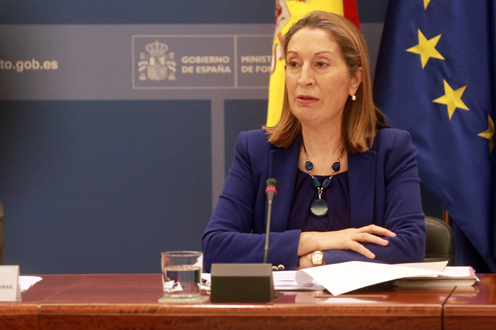Sunken Russian fishing vessel
Conclusion of work to install domes to prevent fuel leaking from Oleg Naydenov
News - 2015.7.27
In Las Palmas on Monday morning, the Minister for Public Works, Ana Pastor, presided over a meeting of the coordination committee set up to deal with the consequences from the sinking of the Oleg Naydenov. After the meeting, Ana Pastor reported that work has finished on installing the domes that will prevent the fuel remaining inside the sunken vessel from leaking into the sea.
The Spanish minister underlined the importance of carrying out this work, which forms part of a final solution, given that it has enabled the pollution to be stopped and will avoid new leaks from the Oleg Naydenov in the future.
The method to transfer fuel from the Oleg Naydenov consists of installing rigid domes over the leaks. Each dome is connected to a tank that, once full, is raised to the surface and replaced with an empty tank so the fuel can be removed. Once the domes were installed, the fuel extraction stage began with the first transfer tank being raised to the surface. After the fuel extraction process is complete, all the leak points will be sealed permanently.
A base of operations has been set up on board the Olympic Zeus, located at the site of the sinking 15 miles south of Maspalomas. Two ROVs (Remotely Operated Underwater Vehicles) were used to put the domes in place because the vessel came to rest at a depth of 2,700 metres.
Emergency status lowered
At the meeting and after an assessment of the situation by the coordination committee, the Director-General for the Merchant Navy, Rafael Rodríguez Valero, announced a lowering of the emergency status from level 2 to level 1, in accordance with the procedure established by the National Maritime Plan.
Sea and air team
As a precautionary measure, the sea and air team coordinated by Maritime Rescue activated on the day of the sinking will continue its surveillance activities.
To date, the air operation has involved Maritime Rescue aeroplanes, helicopters from the Canary Islands and regular satellite images taken by EMSA (European Maritime Safety Agency). The Maritime Rescue vessel Luz de Mar has remained in the area where the fishing vessel sank while the Miguel de Cervantes, Punta Salinas and Guardamar Talía have performed surveillance duties to the south and south-west of Gran Canaria.
Both the Ministry of Agriculture, Food and Environmental Affairs and the Regional Government of the Canary Islands have implemented their surveillance, beach clean-up and wildlife response programmes.





